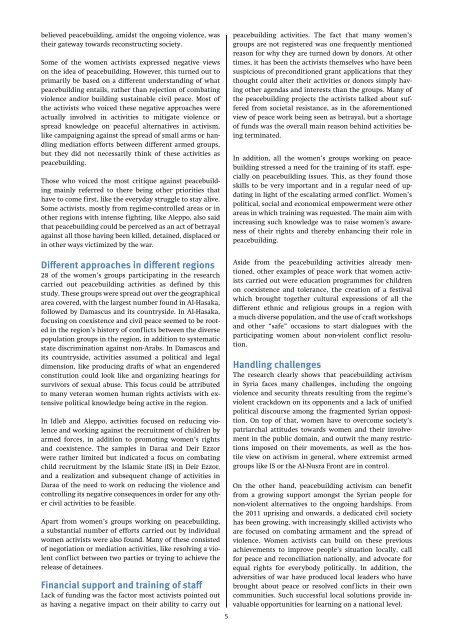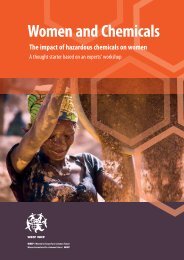future now”
YAO19
YAO19
Create successful ePaper yourself
Turn your PDF publications into a flip-book with our unique Google optimized e-Paper software.
elieved peacebuilding, amidst the ongoing violence, was<br />
their gateway towards reconstructing society.<br />
Some of the women activists expressed negative views<br />
on the idea of peacebuilding. However, this turned out to<br />
primarily be based on a different understanding of what<br />
peacebuilding entails, rather than rejection of combating<br />
violence and/or building sustainable civil peace. Most of<br />
the activists who voiced these negative approaches were<br />
actually involved in activities to mitigate violence or<br />
spread knowledge on peaceful alternatives in activism,<br />
like campaigning against the spread of small arms or handling<br />
mediation efforts between different armed groups,<br />
but they did not necessarily think of these activities as<br />
peacebuilding.<br />
Those who voiced the most critique against peacebuilding<br />
mainly referred to there being other priorities that<br />
have to come first, like the everyday struggle to stay alive.<br />
Some activists, mostly from regime-controlled areas or in<br />
other regions with intense fighting, like Aleppo, also said<br />
that peacebuilding could be perceived as an act of betrayal<br />
against all those having been killed, detained, displaced or<br />
in other ways victimized by the war.<br />
peacebuilding activities. The fact that many women’s<br />
groups are not registered was one frequently mentioned<br />
reason for why they are turned down by donors. At other<br />
times, it has been the activists themselves who have been<br />
suspicious of preconditioned grant applications that they<br />
thought could alter their activities or donors simply having<br />
other agendas and interests than the groups. Many of<br />
the peacebuilding projects the activists talked about suffered<br />
from societal resistance, as in the aforementioned<br />
view of peace work being seen as betrayal, but a shortage<br />
of funds was the overall main reason behind activities being<br />
terminated.<br />
In addition, all the women’s groups working on peacebuilding<br />
stressed a need for the training of its staff, especially<br />
on peacebuilding issues. This, as they found those<br />
skills to be very important and in a regular need of updating<br />
in light of the escalating armed conflict. Women’s<br />
political, social and economical empowerment were other<br />
areas in which training was requested. The main aim with<br />
increasing such knowledge was to raise women’s awareness<br />
of their rights and thereby enhancing their role in<br />
peacebuilding.<br />
Different approaches in different regions<br />
28 of the women’s groups participating in the research<br />
carried out peacebuilding activities as defined by this<br />
study. These groups were spread out over the geographical<br />
area covered, with the largest number found in Al-Hasaka,<br />
followed by Damascus and its countryside. In Al-Hasaka,<br />
focusing on coexistence and civil peace seemed to be rooted<br />
in the region’s history of conflicts between the diverse<br />
population groups in the region, in addition to systematic<br />
state discrimination against non-Arabs. In Damascus and<br />
its countryside, activities assumed a political and legal<br />
dimension, like producing drafts of what an engendered<br />
constitution could look like and organizing hearings for<br />
survivors of sexual abuse. This focus could be attributed<br />
to many veteran women human rights activists with extensive<br />
political knowledge being active in the region.<br />
In Idleb and Aleppo, activities focused on reducing violence<br />
and working against the recruitment of children by<br />
armed forces, in addition to promoting women’s rights<br />
and coexistence. The samples in Daraa and Deir Ezzor<br />
were rather limited but indicated a focus on combating<br />
child recruitment by the Islamic State (IS) in Deir Ezzor,<br />
and a realization and subsequent change of activities in<br />
Daraa of the need to work on reducing the violence and<br />
controlling its negative consequences in order for any other<br />
civil activities to be feasible.<br />
Apart from women’s groups working on peacebuilding,<br />
a substantial number of efforts carried out by individual<br />
women activists were also found. Many of these consisted<br />
of negotiation or mediation activities, like resolving a violent<br />
conflict between two parties or trying to achieve the<br />
release of detainees.<br />
Financial support and training of staff<br />
Lack of funding was the factor most activists pointed out<br />
as having a negative impact on their ability to carry out<br />
5<br />
Aside from the peacebuilding activities already mentioned,<br />
other examples of peace work that women activists<br />
carried out were education programmes for children<br />
on coexistence and tolerance, the creation of a festival<br />
which brought together cultural expressions of all the<br />
different ethnic and religious groups in a region with<br />
a much diverse population, and the use of craft workshops<br />
and other “safe” occasions to start dialogues with the<br />
participating women about non-violent conflict resolution.<br />
Handling challenges<br />
The research clearly shows that peacebuilding activism<br />
in Syria faces many challenges, including the ongoing<br />
violence and security threats resulting from the regime’s<br />
violent crackdown on its opponents and a lack of unified<br />
political discourse among the fragmented Syrian opposition.<br />
On top of that, women have to overcome society’s<br />
patriarchal attitudes towards women and their involvement<br />
in the public domain, and outwit the many restrictions<br />
imposed on their movements, as well as the hostile<br />
view on activism in general, where extremist armed<br />
groups like IS or the Al-Nusra Front are in control.<br />
On the other hand, peacebuilding activism can benefit<br />
from a growing support amongst the Syrian people for<br />
non-violent alternatives to the ongoing hardships. From<br />
the 2011 uprising and onwards, a dedicated civil society<br />
has been growing, with increasingly skilled activists who<br />
are focused on combating armament and the spread of<br />
violence. Women activists can build on these previous<br />
achievements to improve people’s situation locally, call<br />
for peace and reconciliation nationally, and advocate for<br />
equal rights for everybody politically. In addition, the<br />
adversities of war have produced local leaders who have<br />
brought about peace or resolved conflicts in their own<br />
communities. Such successful local solutions provide invaluable<br />
opportunities for learning on a national level.



